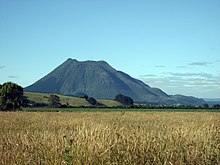| This is a user sandbox page, not a Wikipedia article. This page is used for the development of future articles on Wikipedia, or for the expansion of existing articles. The information on this page may not yet meet Wikipedia's quality standards and is subject to change. |
| Ngāti Awa | |
|---|---|
| Iwi (tribe) in Māoridom | |
 Pūtauaki, ancestral mountain of Ngāti Awa | |
 | |
| Rohe (region) | Bay of Plenty Region |
| Waka (canoe) | Mātaatua |
| Population | 15,258 |
Ngāti Awa is a Māori iwi (tribe) traditionally centred in the eastern Bay of Plenty Region of New Zealand. Ngāti Awa traces its origins to the arrival of Polynesian settlers to New Zealand aboard the Mātaatua canoe, estimated to have arrived in the Bay of Plenty around 1350 AD. Oral traditions indicate that the Mātaatua voyagers landed at Whakatane and settled with earlier Polynesian arrivals living in the area. The iwi takes its name from two ancestors named Awanuiārangi who lived in Whakatane. In its traditional eastern Bay of Plenty base, Ngāti Awa lived alongside fellow Mātaatua tribes Ngāi Tūhoe and Te Whakatōhea, as well as Ngāti Tūwharetoa and the tribes of Te Arawa. Ngāti Awa also has historic ties to iwi across the North Island of New Zealand.
Europeans began settling in New Zealand from the late 18th century, and Māori across New Zealand began to adopt European customs and ways of living. European expansion into Ngāti Awa territory was initially limited, starting with traders in the 1830s. In 1840, Ngāti Awa chiefs signed the Treaty of Waitangi, and for 20 years lived in peace and prosperity. However, Ngāti Awa and other eastern Bay of Plenty tribes came into conflict with the New Zealand government and Crown-allied Māori during the New Zealand wars. Over 1000 km2 of Ngāti Awa land was confiscated by the colonial government, sending the tribe into a severe social, cultural and economic decline. European settlement grew rapidly in the eastern Bay of Plenty following the wars and confiscations. Māori across New Zealand gradually adopted Western lifestyles: many Ngāti Awa people gained seasonal employment and migrated to larger towns and cities. In the 1980s, Ngāti Awa began efforts to settle its historical grievances through the Waitangi Tribunal. Twenty years of research and negotiations culminated in a settlement being reached between Ngāti Awa and the New Zealand government in 2003.
In the 2006 Census, 15,258 people registered their affiliation with Ngāti Awa, making it the tenth-largest iwi in New Zealand. As of August 2011, at least 19,000 people have been listed as members of the tribe. Most Ngāti Awa people live in the eastern Bay of Plenty; other substantial populations exist in Auckland, Wellington and the Waikato. Ngāti Awa is subdivided into 22 hapū (subtribes): 20 hapū are located in the Bay of Plenty, with one each located in Auckland and Wellington. Many of the tribe's marae are concentrated near Whakatane and the town of Te Teko. The iwi is administered by Te Rūnanga o Ngāti Awa, which negotiates with government authorities on behalf of the tribe, as well as managing tribal assets and providing social services. Ngāti Awa also runs a wananga (tribal university), a hauora social health centre and a radio station.
The tribe's traditional rohe (tribal territory) roughly extends from Ohiwa Harbour and Whakatane westwards across the Rangitaiki Plains. Prominent geographical landmarks in the Ngāti Awa rohe feature in tribal oral traditions, and continue to hold symbolic importance: these include the mountain Pūtauaki; the Tarawera, Rangitaiki and Whakatane Rivers; and the islands of Moutohorā, Whakaari and Te Paepae o Aotea. Ngāti Awa culture was devastated following the wars and confiscations of the 1860s. The 1960s saw a resurgence in Māori culture nationally, and since settling its historical grievances Ngāti Awa has continued efforts to preserve its local cultural traditions. The Mātaatua wharenui – built to symbolically unify an aggrieved people, and for more than a century exhibited around the world – will take centre place from September 2011 in a new marae and cultural centre for Ngāti Awa.